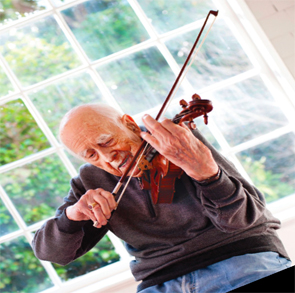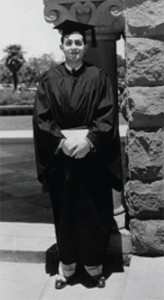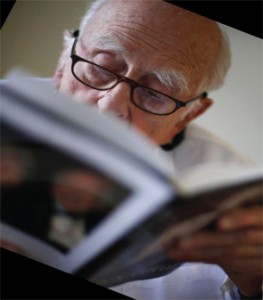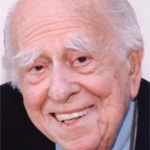
Dr. Engleman played the violin from the age of 2 throughout his life.
Two years ago, at the age of 102, rheumatologist Ephraim P. Engleman, MD, FACR, FACP, published a memoir, My Century, in which he detailed his personal and professional accomplishments, as well as his secrets to longevity. With his characteristic sense of humor, Dr. Engleman noted that the first secret to a long life is to “make sure you get parents with good genes.” No. 3 on that list was to enjoy one’s work, a precept that Dr. Engleman embodied till the end of his life. “Eph,” as he was affectionately known by his colleagues, died Sept. 2, while working in his office at the Division of Rheumatology at the University of California, San Francisco (UCSF).
“Eph [pronounced ‘Ef’] was a remarkable man, not only for the length of his life, but also [for] the way he lived his life,” says Lindsey A. Criswell, MD, MPH, DSc, Jean S. Engleman Distinguished Professor and chief of the Division of Rheumatology, UCSF. She notes that the way in which he integrated his three major passions—his commitment to advancing the field of rheumatology, his dedication to his family and his lifelong love of music—made him “a role model for all those who had the privilege of working with him. For those of us who have been part of the UCSF rheumatology program, there is no one who has had a greater impact on our work than Eph Engleman,” she says. “We will be forever grateful for his generous and enduring support of our program.”

Dr. Engleman celebrates his 104th birthday at UCSF in March 2015. (photo courtesy of David Wofsy, MD)
In his nearly 70-year academic medical career, Dr. Engleman made prodigious contributions to the growth of the UCSF research and training program and to the national research agenda for arthritis. A past president of the ACR (then known as the American Rheumatism Association), Dr. Engleman received numerous awards for his distinguished career in rheumatology, including the ACR’s Presidential Gold Medal, the prestigious Gold Medal from the Columbia University College of Physicians and Surgeons, and UCSF’s Medal of Honor. He was also granted honorary membership in the Chinese Medical Association and the rheumatology societies of Australia, France, Japan, Spain and Uruguay.
Career Beginnings
Born in 1911 in San Jose, Calif., Dr. Engleman began playing the violin at age 2, and continued playing throughout his life. In fact, his first job, at 16, was playing violin in an orchestra that accompanied silent films at the Fox California Theater. As a result, he said, it took him six years to complete his undergraduate degree at Stanford University. He did his medical training at Columbia University and was one of the first physicians in the country to train in the new subspecialty of rheumatology.
He had perfect pitch, which, according to Dr. Engleman, helped him secure his rheumatology fellowship. In My Century, he reported that in 1940 he had applied for a fellowship with rheumatology pioneer Walter Bauer, MD, at Massachusetts General Hospital. Rheumatology was a very new field at the time, and the competition to work with Dr. Bauer was “fierce,” Dr. Engleman recalled.

Dr. Engleman on his graduation day at Stanford. (photo courtesy of Engleman family)
At a certain point, Dr. Bauer interrupted their interview and invited Dr. Engleman to accompany the rheumatology team on ward rounds. One of the patients encountered on the rounds was a woman in her 60s who had, in addition to arthritis, a “musical” heart murmur. Dr. Bauer was poised to order a phonocardiogram to determine the rate of vibration of the woman’s murmur. Dr. Engleman asked to listen to her murmur through the stethoscope. “Not being shy, I said I didn’t need the machine,” he recounted. He explained that he had perfect pitch and knew that A, the note customarily played by concertmasters before performances to tune the orchestra’s instruments, is at 440 Hz, or 440 vibrations per second. The note sounded by the woman’s musical heart murmur, he surmised, was “sharper than A,” and around 500 vibrations per second.
Dr. Bauer was so impressed that he told Dr. Engleman, “Forget the interview. You’ve got the job.”
“That is how I became a rheumatologist,” Dr. Engleman cheerfully recounted in the first chapter of his memoir.
Helping Grow the Specialty
Dr. Engleman’s fellowship was cut short when the U.S. entered World War II after the bombing of Pearl Harbor by the Japanese. Three months after Dec. 7, 1941, he enlisted in the Army and was assigned to the Army Medical Corps, working first at the Army Air Forces hospital in Fresno and later transferring to Torney General Hospital in Palm Springs, Calif. There, Dr. Engleman served as chief of a 50-bed rheumatic fever center where he had a “unique opportunity to observe rheumatic fever in adults.”
By that time, Dr. Engleman was married to his wife, Jean, and the couple’s first son, Philip, was born in 1944 in Palm Springs. After his discharge from the military, the Englemans moved back to Northern California. He opened a private practice in San Mateo in 1947 and, for many years, was the only trained rheumatologist in that region. Shortly after, he established the first rheumatology clinic at UCSF. David L. Daikh, MD, PhD, director of the Division’s Research Training Program, notes that although Dr. Engleman was first and foremost a clinician, “he understood that advances in the field that would make a difference for patients’ lives would come from basic research in immunology and the pathogenesis of the rheumatic diseases that we see.”
Dr. Engleman’s second son, Edgar Engleman, MD, professor of pathology and medicine—immunology and rheumatology—at Stanford University School of Medicine, notes that his father came from an era when clinical care was very important. “He was a very good doctor, and he believed in supporting scientific research even if he wasn’t doing it with his own hands.”
That insight was reflected in Dr. Engleman’s involvement at the national level. As early as the late 1950s, he began volunteering with various professional committees and serving on editorial boards of scientific journals, including Arthritis & Rheumatism (1957–61) and Postgraduate Medicine (1971–76). Robert A. Gatter, MD, MACR, former clinical associate professor of medicine, Department of Medicine, University of Pennsylvania, was aware of Dr. Engleman during his years as an active member of the American Rheumatism Association in the 1960s. As the decades progressed, they grew close, as members of an informal group that regularly exchanged scientific information and enjoyed social gatherings.

Dr. Engleman and his wife, Jean, had been married since 1941. (photo courtesy of Engleman family)
“He encompassed so much national and international administration,” Dr. Gatter recalls. “He handled connections in countries around the world and organized huge meetings.”
One of those was the XIV Congress of the International League of Associations for Rheumatology (ILAR), held in San Francisco in summer 1977. (Later, from 1981–85, Dr. Engleman served as ILAR president.)
Dr. Gatter notes that Dr. Engleman’s organizational efforts contributed to the research momentum in the field. He adds, “Once you generate that kind of energy, it does tend to sustain itself.”
A core example of Dr. Engleman’s legacy had its genesis in the mid-1970s, when he was named to lead the National Commission on Arthritis. Convened by Congress to address the inadequate status of arthritis research, teaching and patient care in the U.S., the task force led to the creation of what is now the National Institute of Arthritis and Musculoskeletal and Skin Diseases (NIAMS).
During the same period, Dr. Engleman became “quite close” with actress Rosalind Russell, who in the 1960s developed severe rheumatoid arthritis. Ms. Russell became a vocal advocate, as a public member of the National Arthritis Act Commission, for establishment of more comprehensive arthritis training and research. She died in 1976; three years later, in 1979, after several NIH site visits, Dr. Engleman founded The Rosalind Russell Center for Rheumatology Research at UCSF. The Center was founded with an initial grant of $800,000 from the NIH. Subsequent to that, Dr. Engleman was approached by several friends of Ms. Russell who wanted to establish a foundation to augment the funding. In the 35 years that Dr. Engleman was director, the foundation supported five academic chairs in rheumatology, provided partial support for 130 rheumatology trainees and supplied supplemental funds for faculty members.
‘Missing a Shy Gene’
After his professional career playing in the orchestra for silent films at the Fox California Theater concluded, Dr. Engleman continued to nurture his love of music and performing. He collected rare violins, owning at various times Stradivari and, later, Gaurneri instruments, and played weekly with a string quartet. During summers, he was an active member of The Family, a private men’s club devoted to the arts and an offshoot of the Bohemian Club, which convenes annually in Portola Valley, Calif. Every season was capped by musical variety productions. Dr. Engleman performed and often wrote the narratives and was master of ceremonies for these events.

Dr. Engleman
He was proud of his stage success playing the part of Mick Jagger in 2006, at the age of 95. “He was a showman,” notes Edgar Engleman. “He was missing a shy gene, and from the time he was a teenager as a professional musician, he was very comfortable on stage.”
That quality stood him well as a leader too, says Edgar Engleman. “When it came to organizing and getting things done, he was remarkably effective.” Dr. Gatter seconds that impression: “He was a hard man to say ‘no’ to. But it’s hard for anybody in a given field to say ‘no’ to someone who is winning and who wants you on board. You consider it an honor and a stimulus to your own career to be with somebody like that. You learn so much on the way.”
‘Eph was a remarkable man, not only for the length of his life, but also [for] the way he lived his life.’ —Lindsey A. Criswell, MD
Sustaining the Momentum
Dr. Engleman’s intellectual and financial support of research was unparalleled. Proceeds from My Century support the Research Center, renamed in 2014, the Rosalind Russell/Ephraim P. Engleman Rheumatology Research Center at UCSF; he and his wife, Jean, established the Jean S. and Ephraim P. Engleman Endowment for Rheumatology Research at UCSF; and Dr. Engleman was also the first person to endow an award for residents’ research through the ACR’s Rheumatology Research Foundation: The Ephraim P. Engleman Endowed Resident Research Preceptorship.
Dr. Engleman took a personal interest in the work of young researchers and fellow trainees. “Until the end of his life, his sharp intellect was focused on programmatic issues for the Russell-Engleman Center,” says Dr. Daikh. “And the fact that he died in his office at work—that really underscores the commitment in his life.”
“He looked forward, and rarely looked back,” Edgar Engleman remarks. “He was so optimistic, so organized and goal oriented, but at the same time doing the things that he really loved to do. What a perfect combination.”
“One of his core sparks was that he never lost his sense of humor nor his spiritual energy,” notes Dr. Gatter. “He kept his professional accomplishments in perspective and still had the ability to be personable across the dinner table. He was a delightful person. He was not just a rheumatologist, not just a doctor, not just a scientist. He was a full human being.”Dr. Engleman is survived by his wife of 74 years, Jean of San Mateo; sons Edgar of Atherton and Philip of Los Gatos; daughter Jill Roost of Hillsborough; six grandchildren and three great-grandchildren.
Gretchen Henkel is a medical journalist based in California.
